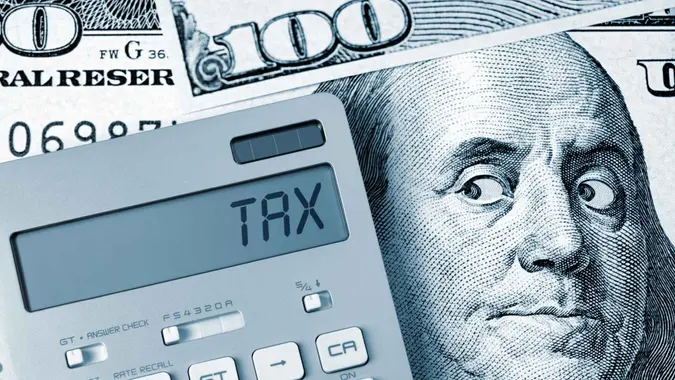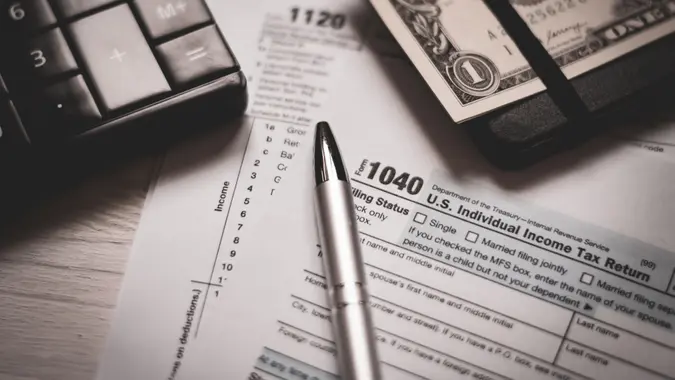8 Tax Surprises If You Are Working Two Jobs at Once

Commitment to Our Readers
GOBankingRates' editorial team is committed to bringing you unbiased reviews and information. We use data-driven methodologies to evaluate financial products and services - our reviews and ratings are not influenced by advertisers. You can read more about our editorial guidelines and our products and services review methodology.

20 Years
Helping You Live Richer

Reviewed
by Experts

Trusted by
Millions of Readers
The days of working just one job are over for the majority of Americans, and most are taking on second gigs to make ends meet. According to a 2022 survey from Insuranks, 93% of working Americans have a side hustle. That number could manage to increase as the country approaches a recession and people feel more threatened by layoffs and general economic unease.
If you’re already among the millions working more than one job, you should be prepared for some curveballs when it comes to filing your taxes. Not only will you owe more in taxes because you made more income, you’ll possibly face some other surprises. Here’s what you can expect, according to a tax expert.
Increased Tax Liability
When your income goes up, so does your tax rate, so if your second (or third) job pops you up into a higher tax bracket, this will increase your tax liability.
“If you’re single and working your first job, you might be on track to make $40,000,” said Levon L. Galstyan, CPA at Oak View Law Group. “The 2022 tax year puts you in the 12% tax bracket. Say you get a second job that pays you an extra $10,000 yearly, bringing your total income to $50,000 per year. Because you now make more than $41,775, part of your income over that amount will be taxed at 22% in 2022.”
There May Be Double Withholding
Since both of one’s employers may withhold federal income taxes, Social Security taxes, and Medicare taxes from your paychecks, this could result in over-withholding. What does that mean for you?
“[It means] you could end up with a lower refund or owe more taxes when you file your return,” Galstyan said.
You May Owe Self-Employment Taxes
More and more people are becoming self-employed — especially if they’re taking on a second gig or side hustle.
“If you have a side gig or freelance work, you’ll be considered self-employed, and you’ll be responsible for paying both the employee and employer portion of Social Security and Medicare taxes, also known as self-employment tax,” Galstyan said. “This tax can be a significant expense, and it’s important to factor it into your budget.”
You’ll Pay Max Social Security Tax
“Let’s begin with the good news because things will only get worse from here on out,” Galstyan said. “U.S. tax laws limit how much each person can pay for Social Security. If you have two jobs and both pay more than $137,700 in 2022, you’ll pay twice as much into Social Security. To put it another way, you’ll pay the maximum Social Security contribution of $8,537.40 per W-2, and there’s no way to tell the other employer to stop withholding your Social Security tax. In the end, you will get a tax credit for the extra Social Security when you file your taxes.”
Now, if you enter your W-2s into any tax software, the excess Social Security tax will be calculated automatically.
“You don’t have to do anything else besides keep track of your expected excess Social Security tax credits on your W-2,” Galstyan said. “For instance, if you did three jobs in a tax year and each paid you more than $137,700 in gross income, you could expect an extra $17,074.80 in Social Security tax credit. This is because the IRS requires that money be taken out of the other two W-2s up to the maximum Social Security liability ($8,537.40 x 2).”
Any tax software will be able to handle this, but it’s worth noting this little labyrinthine detail.
You’ll Likely Pay More Medicare Tax
Those who earn more than $200,000 or $250,000 (single or married) will have to pay an extra 0.9% in Medicare tax.
“When your W-2 wage goes over $200,000, the IRS tells your employer to take out more Medicare tax,” Galstyan said. “Here’s the bad news: you can’t get out of this withholding, and if you have two jobs, neither one will know that you’ve already made more than your threshold, so you’ll have to pay 0.9% of your total gross income over $200,000 to the government.”
You’ll Need To Pay a Tax on Your Net Investment Income
“The Net Investment Income Tax, or NIIT, applies to short-term and long-term capital gains if your gross income, including income from investments, is more than the filing status-based threshold amount,” Galstyan said. “After a certain level of income, this was how Congress taxed investments to pay for the Affordable Care Act (ACA). However, I don’t like that the threshold amount is set in stone and that it hurts families with a mix of W-2 and investment incomes more than other families.”
The most important thing to remember, Galstyan highlights, is that you are accountable for paying both your capital gains taxes and the extra 3.8% NIIT when your gross income is higher than the NIIT threshold amount.
“On the IRS online payments page, you can make estimated payments,” Galstyan said.
 Written by
Written by  Edited by
Edited by 

























